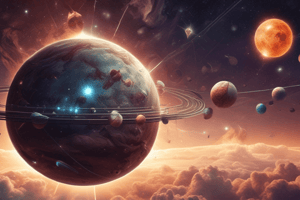Podcast
Questions and Answers
What is the percentage of the Solar System's mass that is in the Sun?
What is the percentage of the Solar System's mass that is in the Sun?
- Over 99.86% (correct)
- Over 90%
- Over 99.99%
- Over 99%
What is the classification of the Sun by astronomers?
What is the classification of the Sun by astronomers?
- G-type brown dwarf
- G-type neutron star
- G-type main-sequence star (correct)
- G-type red giant
What is the outermost region of the Solar System?
What is the outermost region of the Solar System?
- The heliopause
- The Kuiper belt
- The Oort cloud (correct)
- The asteroid belt
Which of the following planets have solid surfaces?
Which of the following planets have solid surfaces?
What is the boundary of the Solar System to interstellar space?
What is the boundary of the Solar System to interstellar space?
How many dwarf planets are there a strong consensus among astronomers about?
How many dwarf planets are there a strong consensus among astronomers about?
What is the region between Mars's and Jupiter's orbit?
What is the region between Mars's and Jupiter's orbit?
What is formed when the Sun's charged particles are halted?
What is formed when the Sun's charged particles are halted?
Flashcards are hidden until you start studying
Study Notes
The Solar System Formation
- Formed approximately 4.6 billion years ago from a dense molecular cloud collapse
- Collapse resulted in the formation of the Sun and a protoplanetary disc
The Sun
- Typical G-type main-sequence star
- Maintains equilibrium through fusion of hydrogen into helium at its core
- Releases energy from its outer photosphere
The Planets
- Eight planets orbit the Sun
- Four terrestrial planets: Mercury, Venus, Earth, and Mars
- Two gas giants: Jupiter and Saturn
- Two ice giants: Uranus and Neptune
- Terrestrial planets have solid surfaces
- Giant planets do not have a definite surface, composed mainly of gases and liquids
Mass Distribution
- Over 99.86% of the Solar System's mass is in the Sun
- Nearly 90% of the remaining mass is in Jupiter and Saturn
Dwarf Planets
- At least nine dwarf planets: Ceres, Orcus, Pluto, Haumea, Quaoar, Makemake, Gonggong, Eris, and Sedna
Small Solar System Bodies
- Asteroids, comets, centaurs, meteoroids, and interplanetary dust clouds
- Many bodies in the asteroid belt (between Mars and Jupiter) and the Kuiper belt (just outside Neptune's orbit)
Moons
- Six planets and seven dwarf planets have orbiting natural satellites (moons)
The Heliosphere
- Solar wind, charged particles from the Sun, forms the heliosphere
- Halted around 75-90 astronomical units from the Sun, resulting in the heliopause
- Heliosphere boundary marks the edge of the Solar System to interstellar space
The Oort Cloud
- Theorized outermost region of the Solar System, source of long-period comets
- Extends to a radius of 2,000-200,000 AU
Nearest Star
- Proxima Centauri, 4.25 light-years (269,000 AU) away
- Both the Sun and Proxima Centauri are part of the Milky Way galaxy
Studying That Suits You
Use AI to generate personalized quizzes and flashcards to suit your learning preferences.




